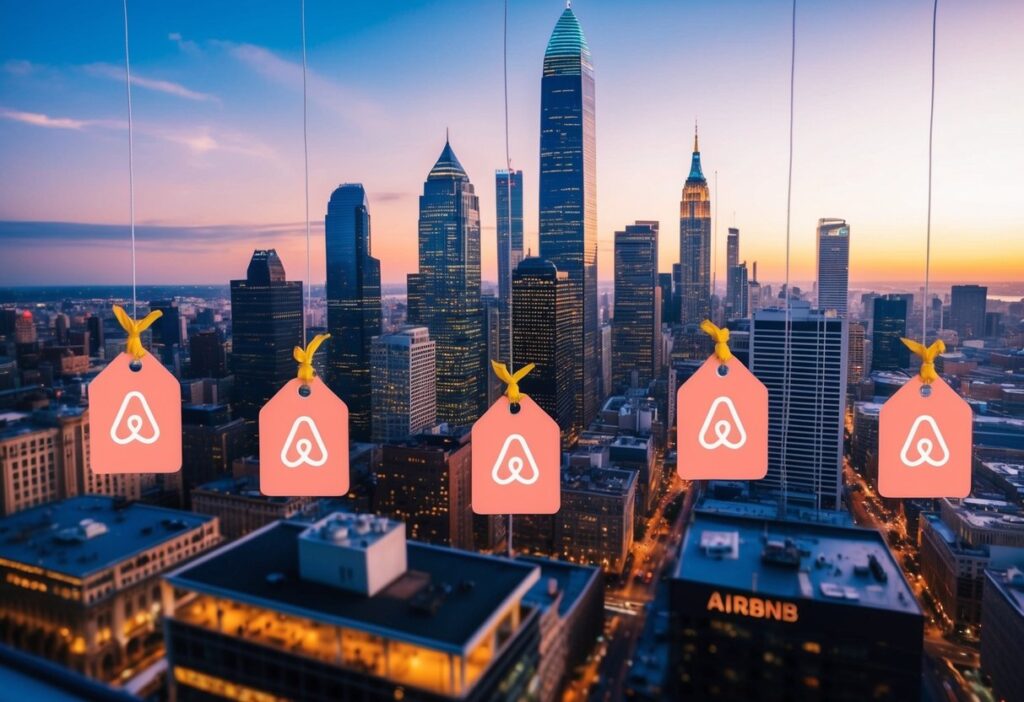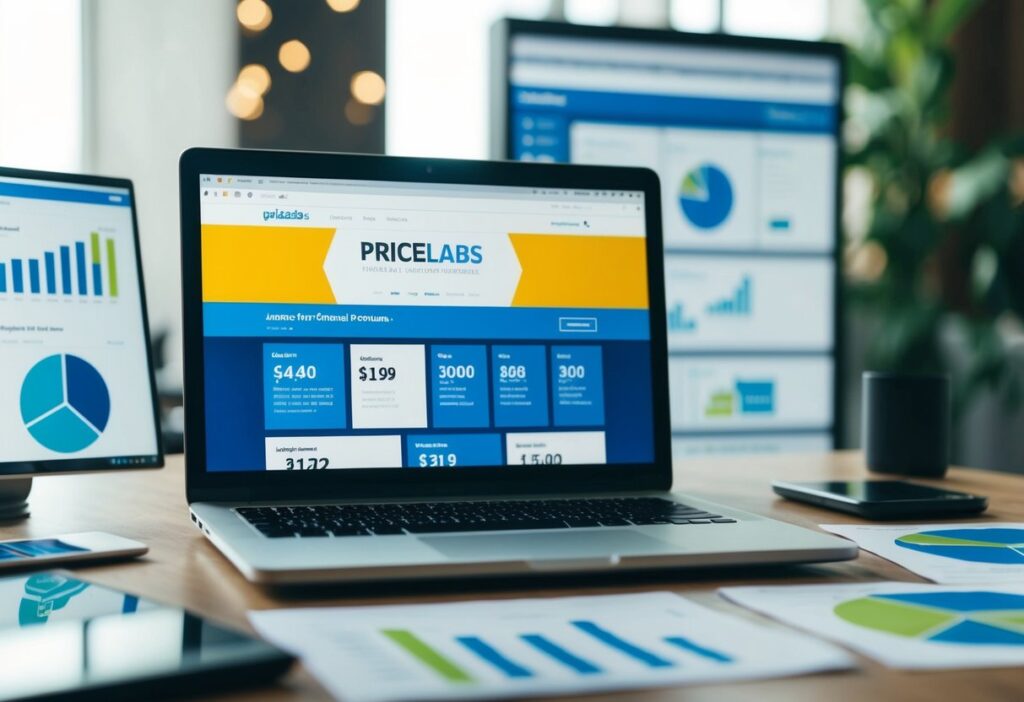Let’s be real—your Airbnb price tag shouldn’t collect dust. If you’re still charging the same rental rates in July and January, you’re not just playing it safe… you’re missing out.
Smart property owners know the key to boosting bookings and income is Airbnb seasonal pricing. Peak season? Time to raise those rates and ride the high-demand periods. Off-season? Roll out irresistible deals to keep the listing’s calendar full. Shoulder season? That’s your sweet spot for fine-tuned flexibility.
The key? Don’t just chase trends—stay two steps ahead by learning to analyze market trends and seasonal patterns. Let’s break down how to price like a pro, no matter the date range.
Key Takeaways:
- Unleash the Power of Dynamic Pricing Tools: Use real-time pricing software alongside manual market reviews to set competitive prices, respond to local demand patterns, and maximize revenue year-round.
- Explore Peak Season Airbnb Seasonal Pricing Strategies: Leverage urgency, local events, and occupancy trends to set premium rates, establish booking rules, and boost earnings during high-demand periods.
- Master Shoulder Season Airbnb Seasonal Pricing Strategies: Fine-tune your dynamic pricing strategy with gradual rate drops, strategic weekly discounts, and dynamic weekday adjustments to maintain momentum between peak and off-peak.
- Maintain Profitability during Off-Season through Airbnb Seasonal Pricing Strategies: Use ultra-competitive rates, long-stay discounts, and niche market targeting (like business travelers) to fill gaps in your calendar and generate steady income during slower periods.
So, use the tools that fit your hosting style, but always layer them with smart seasonal pricing strategies to stay competitive and booked all year long.
Airbnb Smart Pricing vs. Third-Party Pricing Tools: Which One Do You Really Need?
Choosing the right pricing tool on Airbnb can change your earnings. It can turn mediocre returns into maximum revenue. Should you trust Airbnb’s Smart Pricing, or use a third-party pricing tool (PriceLabs, Beyond, or Wheelhouse)?
The answer depends on your goals, hosting style, and how hands-on you want to be. Let’s break it down.
Focus: Occupancy vs. Profit
Airbnb Smart Pricing is designed to keep your calendar full—it prioritizes occupancy. This may get you bookings, but it can lower your listing’s rental rates during peak periods. Third-party pricing tools focus on boosting revenue potential. They’re ideal for hosts and property owners looking to grow revenue, not just get heads in beds.
Data Control & Customization
Smart Pricing gives you limited input. You can set a price range, but Airbnb does the rest. Third-party tools offer full control. You can adjust pricing based on booking lead time, local events, historical booking data, specific dates, and more. If you want advanced settings, customization, and visibility, go with third-party tools.
Ease of Use & Automation
For new hosts or those with one property, Airbnb Smart Pricing is easy to use. There’s no extra cost or setup. Just turn it on. Third-party tools need some setup and often charge monthly prices or a percentage of bookings. They offer automated intelligence. This can increase your earnings and cover their costs.
Reaction Time to Market Changes
Airbnb Smart Pricing might not keep up with local market changes. This is true during sudden demand spikes. These can happen at festivals, holidays, or during bad weather. Third-party platforms are built to respond quickly. They track demand signals in real time. Then, they adjust your rates in hours, not days. This way, you can stay ahead of your competitors.
Type of Host You Are
- Occasional Host? Smart Pricing might be enough to keep things simple.
- Full-time or multi-property host? Go third-party. The additional features, insights, and ROI potential are worth it.
Using Airbnb Smart Pricing or another third-party tool (PriceLabs, Beyond, or Wheelhouse) is key to attract bookings and boosting your revenue. A strong pricing strategy based on seasonal patterns helps you achieve this.
Automated tools help with rate adjustments, but they don’t replace the power of human insight. Strategic moves can greatly impact your profits. Think about increasing prices during high season or offering early-bird discounts. Target business travelers in off peak times or slower periods, too. These steps are important for guest satisfaction and steady income.
Use the tool that matches your hosting style. Also, add smart seasonal pricing strategies. This helps you stay competitive and booked all year.
Peak Season Airbnb Seasonal Pricing Strategies
Pricing your Airbnb listing isn’t about setting a number—it’s about staying ahead of demand. The market shifts daily, and third-party dynamic pricing tools help you react in real time. If you’re still relying on static pricing, you’re leaving money on the table.
It’s time to upgrade your pricing game. Automate rate adjustments to maintain a competitive edge and significantly increase your revenue potential.
Strategy #1: Calendar Blocking to Drive Urgency
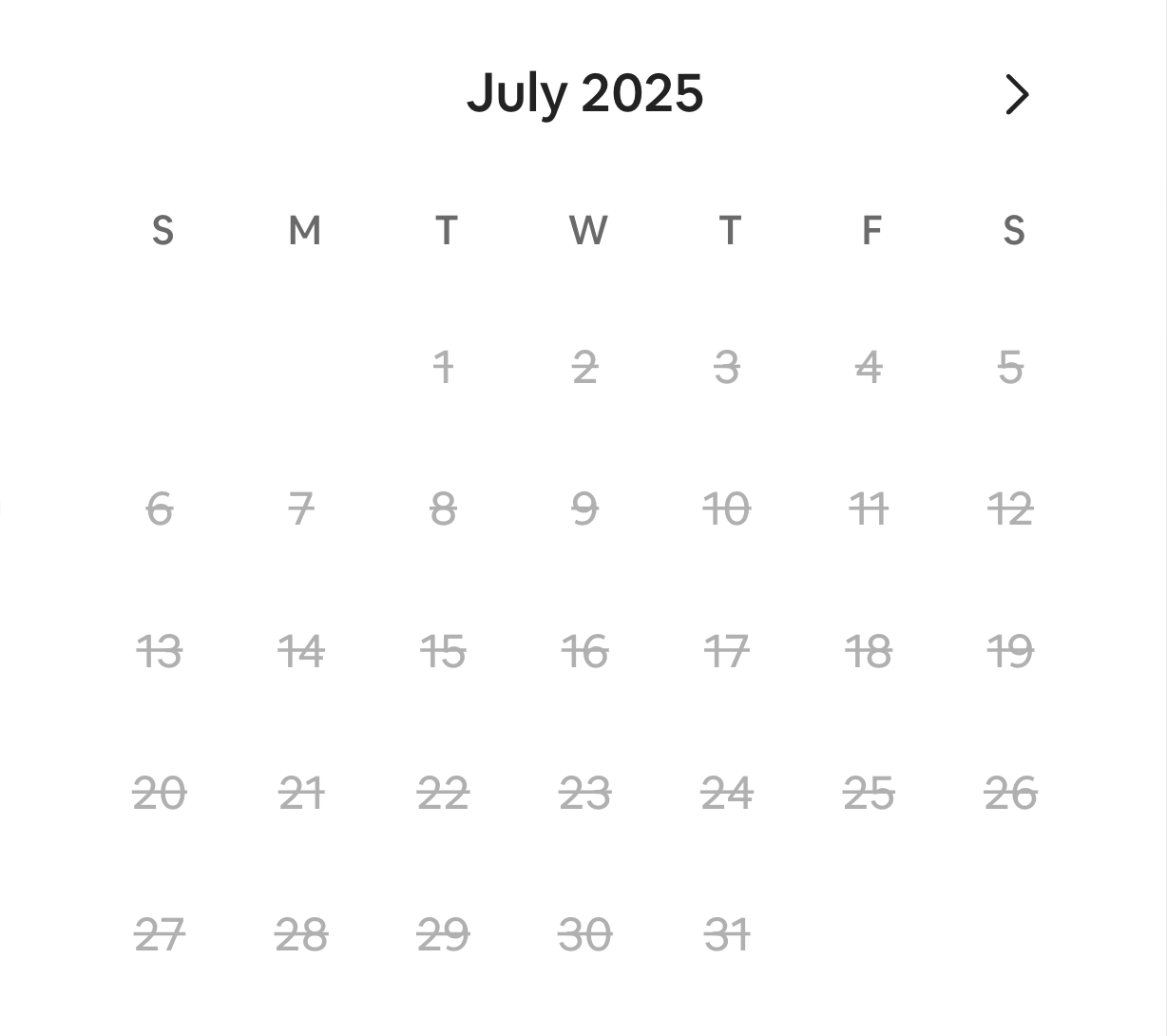
Keep your Airbnb calendar blocked during peak season until your competitors’ listings begin filling up
Peak season means high demand, but it also means fierce competition. Many Airbnb hosts open their calendars far in advance. They want to get early bookings. But this often results in undervaluing your listing. You could miss out on better pricing opportunities. Calendar blocking changes the game. It limits availability, making your property seem more valuable. This sense of scarcity boosts its appeal.
Block your calendar until near specific dates in peak season. This way, you can take advantage of last-minute travelers. As nearby listings fill up, fewer options remain, making your property more desirable.
When demand is high, guests usually pay much more for limited options. This approach helps you charge the right price when needed. You won’t set lower rates too early.
🔥 Why This Works: Airbnb listings with scarcity usually have higher Average Daily Rates (ADR) than those booked early. Studies show that 56% of travelers book last minute. This means many guests pay premium prices due to time constraints. Open your calendar with careful consideration when nearby options are few. This helps your property earn more money each night.
✨ Pro Tip: Track local market demand and competitor pricing. Set higher maximum prices if nearby properties are 80% booked. This shows high season demand. Adjust your rates based on market conditions and historical booking patterns of your listing.
Strategy #2: Gradual Price Increases as Occupancy Rises
Pricing your Airbnb listing or your short-term rental isn’t about setting a number—it’s about adapting to demand. A smart way to boost revenue in high season is to raise rates slowly as your listing gets booked. This strategy lets you capture early bookings at a good rate. You can keep higher prices for guests who book closer to their stay.
Raise rates in small increments at key occupancy levels such as 50%, 70%, and 90%. This keeps your listing attractive at first. It also helps you meet last-minute demand. This data-driven approach helps you avoid underselling popular dates. It also lets you boost earnings while keeping the initial interest high.
🔥 Why This Works: Gradually increasing prices as your occupancy climbs allows you to capture early interest with competitive rates while reserving higher rates for last-minute bookings when demand tends to spike. This approach helps you maximize earnings from guests who book closer to their stay—who are often willing to pay more. Unlike Airbnb Smart Pricing, which prioritizes filling your calendar (sometimes at the expense of revenue), this method balances occupancy with profitability by adjusting prices based on actual demand patterns.
✨ Pro Tip: Find key occupancy levels like 50%, 70%, and 90%. Then, raise prices a bit when you hit those targets. Use dynamic pricing tools or manual checks to track real-time booking trends. If demand rises quickly, change your rates. This way, you won’t miss out on earnings.
Strategy #3: Premium Weekend and Local Event Surges
Not all peak season days have the same value. Peak season brings more bookings. Weekends and local events, like festivals, sports tournaments, and conferences, increase demand on top of that. Smart Airbnb hosts don’t only use seasonal pricing. They also adjust rates with careful consideration during other busy times during high season to maximize revenue.
Raising prices on event dates helps your listing match demand. Local event guests often pay extra for convenience and closeness. The key is to find a balance. Stay competitive and take advantage of peak pricing opportunities.
🔥 Why This Works: Special events create extra demand. This lets you charge higher rates. Adjusting prices based on event demand helps you boost revenue. It also keeps your property a top choice for travelers wanting to be near the action.
✨ Pro Tip: Research local events 6+ months in advance and mark peak dates on your pricing calendar. Increase rates in small increments as demand grows. Also, think about requiring a minimum stay for busy weekends. Keep an eye on competitor prices before the event. Use dynamic pricing tools to adjust your rates based on real-time booking trends.
Strategy #4: Setting Minimum Stay Requirements
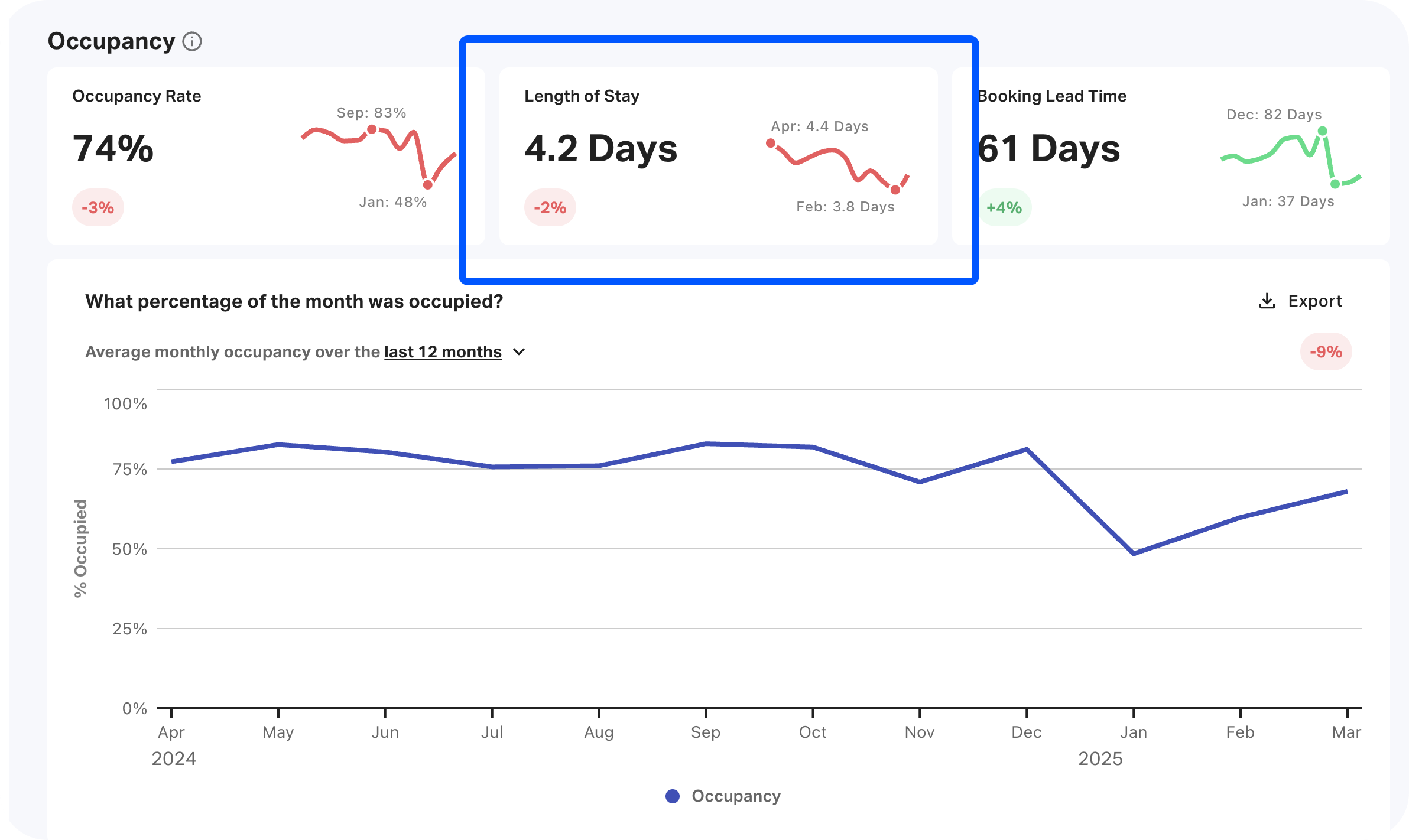
AirDNA provides the average length of stay for your market, helping you set appropriate minimum stay requirements
During peak season, short one-night stays can hurt profits. This happens because of frequent turnovers and cleaning costs. A minimum stay strategy helps your property attract guests who book longer stays. This leads to fewer gaps between reservations and maximizes revenue for each stay. This approach suits travelers seeking week-long vacations or long weekends. It’s a win-win for hosts and guests.
Setting minimum stays helps you keep high-demand dates open for longer bookings. This way, you earn more money from each reservation. Aim for higher-value bookings. Don’t just fill your calendar with short, low-value stays. It’s important to stay flexible. If competitors have shorter stays and your occupancy drops, changing your rules helps increase bookings.
🔥 Why This Works: Setting minimum stay requirements reduces operational costs and helps you secure longer, higher-value reservations, especially during peak season. Fewer turnovers mean fewer cleaning fees, less wear and tear, and more efficient calendar management. It also helps keep your listing available for travelers planning longer vacations, which leads to higher revenue per booking compared to short, one-night stays.
✨ Pro Tip: Set a base minimum stay (e.g., 2–3 nights) and adjust for peak demand periods (e.g., 5–7 nights). Use historical booking data to identify the most profitable length-of-stay trends. If occupancy rates fall, lower the minimum stay requirement. This helps fill gaps and boosts overall revenue.
Strategy #5: Last-Minute Markups for Immediate Revenue
Many hosts think last-minute discounts are the only way to boost revenue. Yet, a last-minute markup can also boost revenue during peak season. When supply is low, last-minute travelers face fewer choices and feel more urgency. This makes them willing to pay more for immediate availability. Hosts can raise nightly rates in the final booking window. This helps you earn more from last-minute planners instead of offering discounts.
Raise prices for short booking windows, like 1–3 days before check-in. This helps you meet urgent demand and keeps your listing profitable. This strategy needs close market watching. If competitors give last-minute discounts, you may need to adjust to stay competitive.
🔥 Why This Works: Discounting is common, but you can keep pricing power with smart markups. Hosts can boost rental income by raising rates during busy, last-minute times. This way, you don’t lower your listing value for nothing.
✨ Pro Tip: Try a gradual markup method. Raise rates in small steps as check-in gets closer. Update your listing’s description to create urgency. For example, say, “Limited availability—book now before it’s gone!” Keep an eye on competitor prices. If needed, change your rates to stay competitive and still make a profit.
Strategy #6: Early Bird Premiums to Secure Advance Bookings

AirDNA also provides the average booking lead time for your market, which you can use to set appropriate early bird premium pricing
Many hosts give early-bird discounts to boost advance bookings. Charging a small extra fee during busy times can also be effective and boost profits. Travelers who want certainty often pay extra to book their preferred dates and spots in advance. Early-bird premiums help you secure revenue before busy times. This approach also keeps your pricing strong.
This strategy lowers the chance of empty peak dates because you open your calendar far in advance. It also helps measure booking demand several months before the busy season starts. It makes sure your best nights aren’t sold for less than they’re worth. If demand slows, adjustments can be made closer to the check-in date.
🔥 Why This Works: Advance sales can cover up to 80% of total bookings. This creates a stable revenue stream before the peak season starts. Encouraging travelers to book early helps you ensure steady income. It also allows you to stay flexible with your pricing strategy.
✨ Pro Tip: Set an early bird window (e.g., 3–6 months before peak season) to assess demand. If bookings are slow, lower the premium over time or add special offers to keep things moving. Use dynamic pricing tools to ensure your rates stay competitive while maximizing revenue.
Shoulder Season Airbnb Seasonal Pricing Strategies
Setting prices for your Airbnb in the shoulder season is not just about costs. It’s about making the most of each booking chance. Demand changes between busy and slow seasons. Relying on fixed rates leads to lost revenue.
It’s time to fine-tune your pricing strategy. Adjust your rates wisely to draw in more guests and boost profits during the shoulder season.
Strategy #7: Gradual Price Reductions for Evolving Demand
As peak season ends, demand drops. But you shouldn’t cut prices right away. A gradual price reduction strategy during the shoulder season keeps your listing competitive while maintaining profitability. Small, gradual price drops keep revenue higher than sudden cuts.
By looking at past booking trends, you can predict changes in demand. Then, you can adjust your pricing to match. This approach helps avoid sudden changes to off-season rates. It also keeps your occupancy rate steady. A smart price decline helps you grab the last bit of demand at the best rates.
🔥 Why This Works: Big price cuts can hurt your listing throughout the year. Small, smart reductions keep your property attractive without showing panic. A controlled pricing transition helps secure last-minute bookings while preserving pricing power.
✨ Pro Tip: Analyze post-peak booking trends to determine when demand starts to drop. Implement small weekly or bi-weekly price reductions and track competitor pricing. Use dynamic pricing tools to automate gradual adjustments based on real-time market conditions.
Strategy #8: Weekly Discounts to Attract Extended Stays
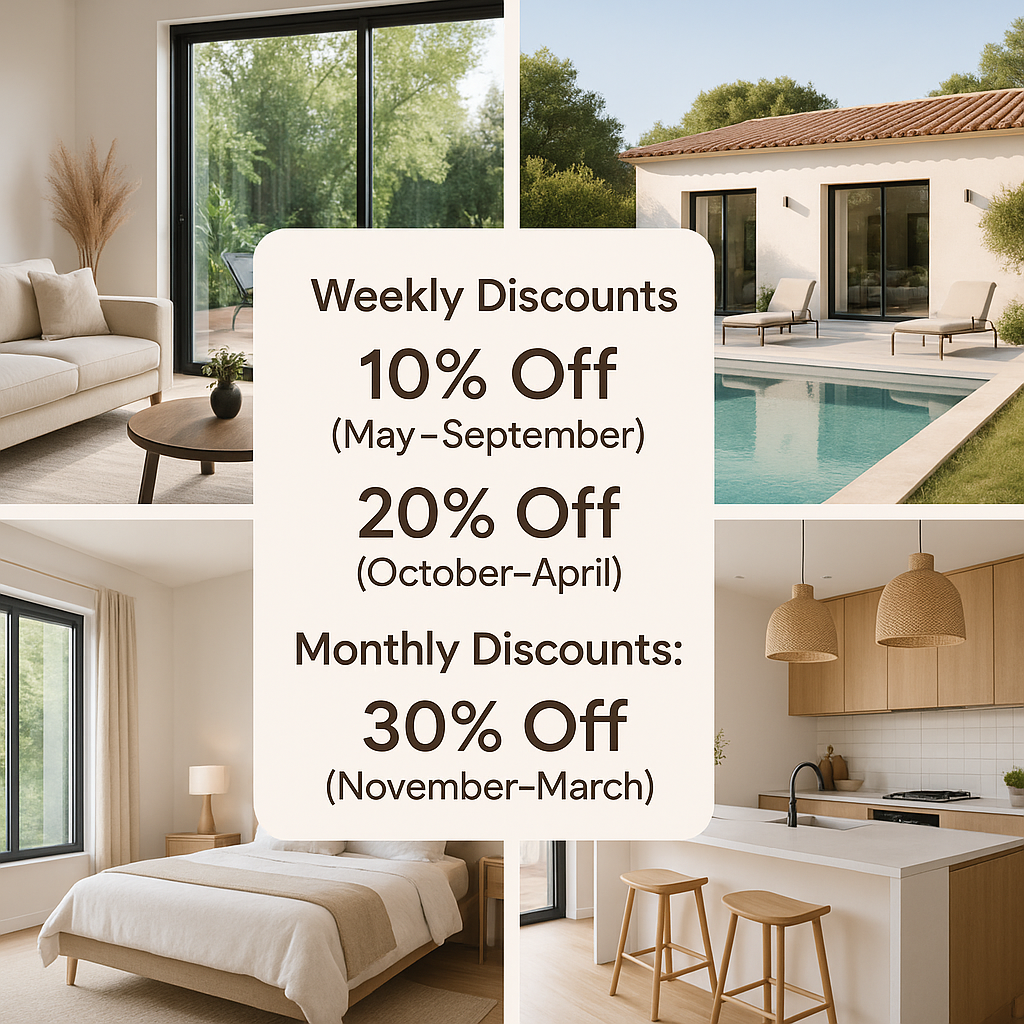
Showcase available discounts in both your gallery and your Airbnb listing description
During the shoulder season, demand slows. To keep occupancy rates high, consider offering weekly discounts. This strategy helps attract guests without significantly decreasing revenue. Travelers like remote workers, families, and long-term vacationers often want mid-length stays. A good discount can make your listing stand out. This way, it becomes more appealing than those offering standard nightly rates.
This strategy brings in guests and cuts costs from frequent turnovers. Offering a small discount on weekly stays gives better value. This way, you don’t underprice your listing. When done right, this method can bring steady revenue and fill your calendar.
🔥 Why This Works: A weekly discount attracts longer stays. This cuts vacancy risks and ensures steady income. Additionally, fewer turnovers lower cleaning and maintenance expenses. This helps make properties more competitive when the market is slow.
✨ Pro Tip: Set a clear weekly rate promotion for 7+ night stays and highlight it in your listing description. Adjust the discount percentage based on demand, competitor prices, and guest stay duration. This keeps your weekly rate appealing and protects your profits.
Strategy #9: Day-of-Week Dynamic Adjustments
Even in the shoulder season, Airbnb demand experiences considerable fluctuations between weekdays and weekends. As a smart host, you should adjust your pricing based on these patterns to maximize earnings. Although weekends usually command higher rates, midweek bookings often experience a decline. Adjusting rates for different days helps you avoid low prices on weekends. This way, you can keep weekday rates attractive for bookings.
This strategy leverages real-time market trends and competitor pricing to optimize revenue. A flexible pricing model helps avoid losing money on busy days. It also keeps lower-demand days from being empty because of high prices.
🔥 Why This Works: Changing rates by day captures peak weekend demand. It also keeps midweek stays affordable for travelers. This approach balances occupancy throughout the week, ensuring a steadier income. Dynamic pricing changes based on demand on certain days. This can boost booking rates and raise revenue.
✨ Pro Tip: Look at past booking data. Find out which weekdays have low demand and which weekends are popular. Increase base rates on weekends and lower weekday rates a bit to boost occupancy. Track local events, business travel trends, and holiday weekends. This helps adjust rates based on what you find. Use dynamic pricing tools to automate these adjustments for optimal performance.
Off-Season Airbnb Seasonal Pricing Strategies
When demand drops, smart hosts don’t panic—they pivot. The off-season is not for resting. It’s your time to plan ahead, keep cash flow steady, and outpace competitors who are less ready. Static pricing won’t work here. Guests care more about prices, so your strategy must show that.
To increase bookings during off-peak times, use the following expert tips:
Strategy #10: Ultra-Competitive Rates to Stay Relevant
In the off-season, short-term rental demand experiences a significant decline. So, it’s important to use a pricing strategy that draws in bookings. Offering great rates, below peak-season prices, keeps guests coming in. Staying booked is often better than having an empty property. It may not earn as much as high-season pricing, but at least it brings in some income.
In a slow market, many hosts make substantial price reductions to secure bookings. To stay relevant, you need to change your rates based on market demands. This way, you can cover your operational costs. Keeping your listing active during off-peak months is important. It helps gather positive reviews and boosts your ranking in Airbnb’s search results.
🔥 Why It Works: Lowering rates fills calendar gaps and stops total revenue loss. Surveys show that lowering prices by 15-25% during off-peak periods helps maintain occupancy. This is compared to those with fixed rates. Competitive pricing helps with visibility in search results. Travelers usually filter listings by price, especially during low-demand times.
✨ Pro Tip: Find your break-even nightly rate. Look at fixed costs like mortgage, utilities, and cleaning fees. Price your stay to stay profitable, but don’t sell yourself short. Keep an eye on competitor rates. Adjust your prices so you stay a top choice for budget-conscious travelers. Use dynamic pricing tools to automate price adjustments in response to market fluctuations.
Strategy #11: Monthly Discounts for Reliable Revenue Streams
Monthly discounts are a smart move during the off-season. They help when demand drops. A discount for stays of 28 nights or more appeals to digital nomads. It also attracts relocating workers, traveling nurses, and families wanting longer visits. These guests want stability and affordability. You gain from steady occupancy and less turnover.
Monthly guests secure longer stays, so they fill your calendar. No more scrambling for nightly bookings at low rates. You’ll save time on check-ins and cleanings. Plus, you’ll keep a steady income. It’s a win-win that keeps your property profitable during slower travel periods.
🔥 Why This Works: According to Airbnb, nearly one in five nights booked on Airbnb is part of a stay that’s 28 nights or more. Longer stays cut vacancy gaps and lower costs. This leads to steadier cash flow. Also, Airbnb’s search algorithm boosts listings for long-term stays. This helps you get noticed by the right travelers.
✨ Pro Tip: Set a monthly rate that’s roughly 20–30% lower than your nightly rate x 28, but still above your break-even point. Highlight the long-stay discount in your gallery and description to grab attention. Use dynamic pricing tools. Compare your listings with similar ones. Adjust your prices as needed to stay competitive in the market.
Strategy #12: Targeting Business Travelers

Include a screenshot of your Airbnb’s internet speed test in your listing’s photo gallery to clearly demonstrate to business travelers that your property offers fast Wi-Fi
When leisure travel slows, business travelers can keep your Airbnb booked. Offering weekly or monthly discounts for professionals helps maintain occupancy during the off-season. Many business travelers seek comfortable and affordable accommodations rather than hotels. They want places with fast Wi-Fi and good workspaces. In fact, 81% of travelers say Wi-Fi is essential during a trip, making it a top amenity to highlight.
Position your listing as a “business-ready” space. Set a competitive price. This way, you attract a niche audience that travels all year. Mention proximity to business districts, coworking spaces, or public transit. Collaborate with local businesses or include “remote work-friendly” in your title. This can help you stand out.
🔥 Why This Works: Business travelers keep bookings steady, even when tourism slows down. Statista reports that 20% of global travel comes from business trips. Hybrid work is leading to longer stays that mix business and leisure. Listings for this audience often stay booked longer and attract more repeat guests.
✨ Pro Tip: Look for local business events or corporate hubs that might draw guests near you. Provide lower nightly rates than nearby hotels. Amenities like a dedicated workspace, quiet surroundings, and high-speed internet are essential. A dedicated workspace helps guests focus. Quiet surroundings promote productivity. Fast internet keeps guests connected and efficient. These features add great value to any environment. Adjust your pricing for peak demand during conferences or industry events.
Strategy #13: Flexible Cancellation to Influence Demand
In the off-season, guests often hesitate to book. They might worry about the weather, work commitments, or shifting travel plans. A flexible cancellation policy can clear up uncertainty. It helps encourage more bookings by lowering perceived risk. Flexible options boost guests’ confidence in booking your place early. Strict terms can make them hesitate.
This strategy works well during colder or transitional months. During these times, travelers are more likely to change their plans. While cancellations can happen, the benefits usually outweigh the risks—you get more calendar activity and a better chance to turn browsing into bookings.
🔥 Why This Works: Flexible policies draw in cautious travelers, especially during slow times. AirDNA says that listings with flexible cancellation policies get booked more often. Reducing booking friction fills open dates, especially far ahead of the season.
✨ Pro Tip: Change your cancellation policy to “Moderate” or “Flexible” in your settings. Emphasize this feature in your title and description, such as “Free Cancellation!” Check your Airbnb performance dashboard. Watch for any rise in occupancy. If cancellations happen too often, change the policy.
Strategy #14: Early Bird Discounts for Off-Peak Bookings
In the off-season, demand drops, and bookings are often last-minute. But early bird discounts can change that. Lower rates for early bookings help secure income during slow times before the rush. This strategy works well if your property is close to popular spots. These can be national parks, warm beaches, or busy urban areas with events.
Early-bird discounts help proactive guests. They boost your occupancy and don’t hurt your revenue like last-minute price cuts do. You create a sense of value without sacrificing long-term pricing power.
🔥 Why This Works: Booking ahead of the off-season helps you fill your calendar. This way, you avoid gaps and stress about vacancies. According to Xola, early bird discounts, just like those on events, can bring a significant boost in booking rates for the hospitality industry. It practically means you are advancing your income while maintaining control over your pricing strategy.
✨ Pro Tip: Find your off-season window, like November to February. Then, give 5–15% discounts on bookings made 90+ days ahead. Promote it in your listing title or listing description with phrases like “Book Early & Save!” or “Off-Season Early Bird Deal.” Use your dynamic pricing tool to gradually lower the discount as the off-season nears. This helps keep your margin steady.
Strategy #15: Orphan Day Discounts to Fill Vacancies
Off-season bookings can be unpredictable. They often create gaps of 1 to 2 days between longer stays. These short windows often remain unbooked in the off-season. A small discount can draw in last-minute travelers or locals seeking a quick escape. Orphan day pricing prevents your property from being vacant for too long. It works best with automated pricing tools that change rates in real time.
Offering lower rates for short stays can boost your occupancy. This helps keep your calendar full, especially in slower months.
🔥 Why This Works: Minimizing empty nights means maximizing occupancy and revenue year-round. Recent surveys show that 92% of U.S. Millennial travelers want the best deal. So, orphan day discounts can help you get spontaneous bookings that others might overlook. This strategy brings income from nights that would have otherwise been wasted.
✨ Pro Tip: Set a specific discount (e.g., 15–20%) for 1–2 night gaps between bookings. Use tools like Beyond, PriceLabs, or Wheelhouse to automatically find and apply discounts to these slots. Track how often these discounts lead to sales. If you’re not seeing enough pickups, change your rate or window.
Additional Tips & Best Practices
A great seasonal pricing strategy goes beyond setting rates. It involves refining, testing, and managing those rates over time. Smart discounts can lose value if you don’t track them often. A few simple tactics can significantly enhance your profits.
Here are the best habits, tools, and partnerships to keep your pricing sharp, listings strong, and calendar full.
1. Raise Your Base Price by 15% to Offer Persuasive Discounts
Increasing your base price by about 15% allows you to provide timely discounts. This way, you can attract customers without hurting your profits. This tactic makes guests feel they are getting more value. A clear promotion, like “15% off this week only,” works well. Deals can sway many travelers. A small discount can increase conversion rates. This is true, especially when people see many similar listings.
This approach is versatile, functioning effectively in both peak and off-peak seasons. During busy times, it lets you keep your prices strong and still look competitive. In slower months, it allows for promotional flexibility. You can avoid deep cuts that might devalue your property. The small price increase helps keep your profits steady. It lets you adjust to changing demand with limited-time offers or booking incentives.
2. Weekly Price Management for Effective Seasonal Pricing
Weekly price management is essential for the effective implementation of seasonal pricing strategies. The short-term rental market changes often. Local events, holidays, weather, and competitors all affect demand. Check your Airbnb’s performance on a regular basis. Look at occupancy rates, pricing against competitors, and future booking windows. This way, you can make quick changes to stay competitive. Weekly reviews are very important during the shoulder seasons. This is when travel patterns change without warning.
Tracking changes such as discounts, policy updates, and price adjustments builds a useful data set. This data will help you make better decisions in the future. Use tools like spreadsheets or pricing software. Log updates and see what works over time. Reviewing past booking trends helps you set your prices wisely for market shifts. This way, you can recognize and take advantage of patterns each year.
3. Hiring a Specialized Airbnb Marketing Agency

Contact us today
Partnering with an Airbnb marketing agency gives you expert help and smart strategies. They excel at adjusting seasonal pricing. These agencies use data-driven tools and industry benchmarks. They watch local demand changes. They adjust nightly rates. They also enhance your listing’s appeal for every season. Their insights often exceed what a regular host can gather. This gives you a real edge in tough markets.
These agencies do more than pricing. They provide services like listing optimization, calendar management, and promotional campaign planning. This helps save you time and boost your returns. Professional help can greatly assist hosts with many properties or little time. It helps keep your property competitive all year and maximizes seasonal opportunities.
Ready to Maximize Airbnb Revenue Year-Round? Let’s Talk!
Stop guessing your nightly rates and start mastering Airbnb seasonal pricing like a pro. Whether it’s peak season markups or off-season strategies, we help you fine-tune every rate, every stay.
With data-driven insights, dynamic pricing tools, and full-service listing support, our experts turn pricing into profit.
📩 Message us today—let’s boost your occupancy and revenue, season after season.
Airbnb Seasonal Pricing Recap: Maximize Profit All Year Long
Smart Airbnb hosts don’t just set prices—they strategically adapt them to match demand. No matter if it’s peak travel time or the slower season, you can boost your revenue. Stay flexible, use data, and stay ahead of your competitors.
Use this recap as a checklist. It helps you adjust your pricing and turn seasonal changes into income opportunities.
Peak Season Airbnb Seasonal Pricing Strategies
- Calendar Blocking to Drive Urgency: Temporarily blocking dates in high-demand months creates scarcity. When you later release those dates at a premium, guests are still likely to book.
- Gradual Price Increases as Occupancy Rises: Increase prices based on booking momentum—raising rates as occupancy builds ensures you earn top dollar from last-minute guests.
- Premium Weekend and Local Event Surges: Charge higher rates on weekends and during major local events. Use event calendars to plan price hikes that align with predictable demand spikes.
- Setting Minimum Stay Requirements: Set a 5 or 7-night minimum stay to reduce turnover and boost profitability per booking during peak demand. This works especially well during holidays or festivals.
- Last-Minute Markups for Immediate Revenue: If your calendar shows limited availability for the coming days, increase prices. Many travelers will pay extra for immediate bookings in a busy season.
- Early Bird Premiums to Secure Advance Bookings: Offer premium pricing for guests booking 3–6 months in advance. Travelers with high intent will book dates early. This gives you guaranteed revenue in advance.
Shoulder Season Airbnb Seasonal Pricing Strategies
- Gradual Price Reductions for Evolving Demand: Ease prices down slowly as the season winds down. A soft decline protects your margins while keeping your listings competitive.
- Weekly Discounts to Attract Extended Stays: Offer 15–20% off weekly bookings to encourage longer stays when short-term demand starts fading. This also helps reduce your cleaning and turnover costs.
- Day-of-Week Dynamic Adjustments: Use pricing tools to vary rates across the week. Lower prices on slower weekdays while keeping weekends competitive to maintain steady occupancy.
Off-Season Airbnb Seasonal Pricing Strategies
- Ultra-Competitive Rates to Stay Relevant: Drop your rates below local competitors during the low season to stay visible and appealing to price-sensitive travelers.
- Monthly Discounts for Reliable Revenue Streams: Offer deep discounts (20–30%) for 28+ night stays to attract remote workers, students, and long-term guests, providing income with fewer turnovers.
- Targeting Business Travelers: Adjust pricing and messaging to attract corporate guests. Highlight features like high-speed Wi-Fi, workspaces, and quiet surroundings.
- Flexible Cancellation to Influence Demand: Switch to flexible or moderate cancellation policies during the off-season. This helps reduce booking hesitation and boosts conversion rates.
- Early Bird Discounts for Off-Peak Bookings: Encourage guests to commit early by offering 10–20% off off-season stays when booked well in advance. This stabilizes cash flow before slow periods.
- Orphan Day Discounts to Fill Vacancies: Offer small discounts on 1-2 night gaps between longer stays. These quick fills help maintain occupancy and reduce unused nights in your calendar.
Additional Tips & Best Practices
- Raise Your Base Price by 15% to Offer Persuasive Discounts: By increasing your base rate slightly, you create room to offer compelling discounts that drive bookings—while still protecting your profit margin.
- Weekly Price Management for Effective Seasonal Pricing: Review your pricing weekly to respond to market shifts, occupancy trends, and competitor behavior. Logging changes and results helps you refine your strategy over time.
- Hiring a Specialized Airbnb Marketing Agency: Agencies can handle dynamic pricing, seasonal strategy, and listing optimization for you. Their expertise often leads to higher occupancy and revenue, especially across fluctuating seasons.
The Bottom Line
Mastering seasonal pricing on Airbnb is crucial for property managers and hosts. It helps you increase revenue throughout the year. You increase profits by changing rates based on demand. You should consider peak, shoulder, and off-seasons. Manual checks, smart pricing tools, and data-driven changes work together. They help keep your prices competitive and aligned with market trends.
Using the strategies in this guide will help you succeed on Airbnb all year, not just in busy travel months. You need to keep an eye on your pricing, occupancy rates, and what competitors are doing. This is key to staying ahead of market changes. Quickly adapting to changes helps you get more bookings and keep guests happy.
Ultimately, success on Airbnb is about being proactive and agile. A smart pricing strategy can raise your bookings, grow your revenue, and improve your reputation as a top host.
Frequently Asked Questions (FAQs)
Q: Should I adjust prices manually or rely on automated tools?
A: A hybrid approach is most effective. Dynamic pricing tools adjust in real-time based on market changes. Check local events, competitor prices, and seasonal trends every week. This way, you can capture every chance to increase revenue. Regular oversight helps you catch changes that automated tools might miss.
Q: How far in advance should I start adjusting my seasonal rates?
A: Start adjusting your rates at least 3 months before each season begins. This time lets you understand market demand. You can check competitor prices and get early bookings. This is key during busy travel times.
Q: Why is it important to set a minimum stay requirement?
A: A minimum stay requirement cuts down turnover. This makes managing bookings easier. It also boosts your average revenue per booking. This happens because it encourages guests to stay longer. As a result, you get larger and more profitable reservations.
Q: Do I need to change my seasonal pricing every year?
A: Yes, it’s important to re-evaluate your seasonal rates annually. Market conditions, demand, and local events change yearly. Adjusting your prices keeps you competitive and increases your earnings. Regular updates will keep your listings in line with new trends and booking habits.



